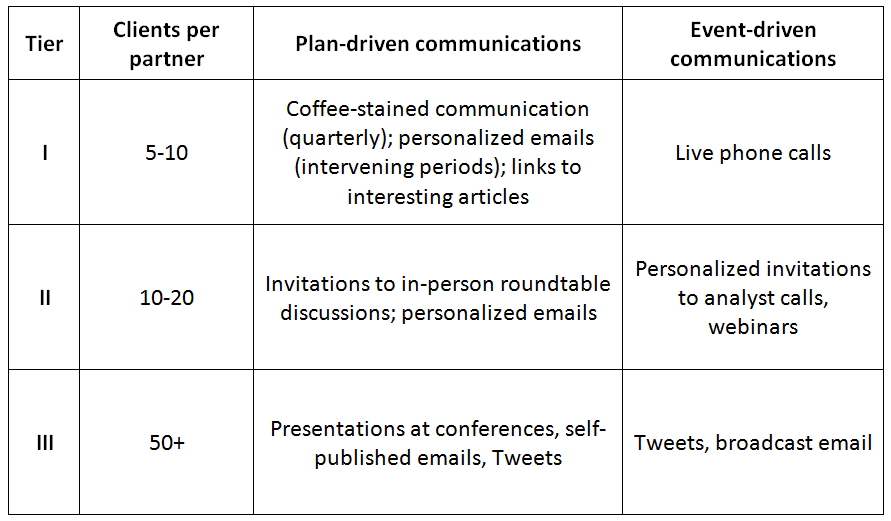Sitting together with clients, chatting informally, openly, with vulnerability; not feeling the need to have all the answers; a back and forth—a conversation. A couple of pages, perhaps, are passed around. Damp ring marks from cups and glasses pepper the pages. This is coffee-stained communication. Your marketing program needs to have this kind of communication as its focal point. Why? Let’s take a step back.
Given today’s increasingly competitive legal marketplace, elite firms have to differentiate. More specifically, their offerings must be differentiated in the minds of clients. Clients should perceive what you offer as something very few, if any, other firms can provide. The stronger the differentiation, the stronger the price realization—and therein the higher the profitability.
That’s one side of differentiation. But to differentiate effectively, law firms have to differentiate twice. The forgotten side is that you must differentiate—sharply—how you allocate your scarce time and resources on client communications and relationship building. There is an inherent tradeoff in communications between “richness” and “reach”—that is, between the quality of the communication and the number of people with whom you communicate. Differentiation requires richness. Richness limits reach. “Coffee-stained communication” addresses both sides of differentiation.
While there are substantive ways to differentiate an offering—for example, through an innovation or an integrated bundle of elements that individually may not be distinct, but their gestalt is unmatched—such opportunities are normally few and far between. As a result, firms need to look too at the opportunities for differentiation in the areas that ”surround” the core offerings and, in particular, the intangible aspects that come from how clients feel about working with a particular lawyer or firm.
There is an inherent tradeoff in communications between “richness” and “reach”—that is, between the quality of the communication and the number of people with whom you communicate.
Lawyers often bristle at this notion. They’re trained to pound out the emotional and focus on facts and logical rigor. They take pride in their substantive prowess, their command of the subtleties, their expertise. And they assume that clients choose lawyers specifically and solely for these qualities. They therefore frequently overlook a countervailing truism: clients often don’t have the expertise to distinguish between the relative expertise of their outside counsel. Rather, they tend to assume that any partner from a top firm is substantively expert.
So how do clients choose a particular lawyer? One way to get at this is to borrow a technique from consumer marketing called laddering (see “Speaker’s Corner“). In particular, you ask “why” five times? Invariably, before the fifth “why” you’ll have hit on emotions. For example, the questions might run like this:
- Why did you use partner A? Because she’d worked with us before on something similar and it had gone well.
- Why did the positive prior experience matter? Because we knew she knew what she was doing, we knew we could work with her.
- Why did her knowing the mandate matter? We were confident we could work with her to get it done.
- Why does confidence matter? It gives us one less thing to worry about.
- Why were you able to worry less? Because we trusted her to get it done right.
Try this out with any client. Warn them upfront that you’re going to ask questions that may seem strange, and you’ll almost always get to a reason based on an emotion, probably around reassurance, trust, not having to worry. If you find yourself asking “Can an emotion really be a reason for a client to hire someone?,” just remember: feelings are facts too.
The implication of this for marketing is straightforward: marketing should be focused on emotional connection. An email doesn’t build trust; one-way broadcast of content doesn’t build trust. What does? In person conversation, two-sided exchange, thinking together—that is, coffee-stained communication.
The second side of differentiation, time and resource allocation, is also bolstered by this type of coffee-stained communication. Partners at elite law firms have to be ambidextrous. On the one hand, they have to be great substantive lawyers. On the other, they’ve to run a sophisticated high-margin business—their practice.
An email doesn’t build trust. What does? In person conversation, two-sided exchange, thinking together—that is, coffee-stained communication.
On the former, they’re trained to be reactive—a call comes in, it’s all hands to the pump. The latter, running a business, is all about planning—identifying the most important things to do and getting them done, not letting the urgent crowd out the important. Having being raised to excel at the former, partners frequently struggle with the latter. A program built around coffee-stained communication forces thoughtful time allocation by requiring focus on the clients and potential clients that matter most.
This is not to say that partners should communicate only with a small number of clients. Rather, they should take a tiered approach. The approach would be something like this:
- Look back at your strategy for the list of priority positions you’re trying to build—what client segments with what offerings and from what locations?
- Identify the topic areas your firm should “own.” What are the themes, the subtopics, and the forthcoming events that will warrant communications? Who are the members of the team (partners, associates, communications support) that will develop the content? Integrate too the awareness that forwarding thoughtful pieces by others is an important part of owning the topic in the minds of clients.
- Identify your audiences. For these audiences, what are the best channels for your message? Who are the journalists that track these topics? What are the publications (it’s better to have a “referenced” publication than to self publish)? What conferences does this audience attend (being wary of conferences that attract lawyers from other firms rather than clients). What Twitter account to use, (increasingly important for younger lawyers at clients)? Can you host Ted-talk style videos of partners discussing key issues?
- Divide the clients in your targeted segments into different buckets by priority, constrained by the reality of the number of clients with whom a partner can connect. Put in place a plan to communicate differently with clients of different priorities, such as in the “plan driven” column in seen below. These will have to be coordinated with CLEs and other initiatives that your client teaming effort is driving. The coffee-stained communications should happen first so that you can integrate what you learn—both on the substance and its positioning—into downstream communications. For the roundtables, be sure to allow time for attendee-to-attendee connection—clients invariably say they get as much (if not more) from such interactions as from talking with a firm’s partners.
- Draw up the plans for event-driven communications around your chosen topics. It will pay off to identify the possible breaking news scenarios in these areas, and to have an outline communication ready to refine and go.The channels might be as in the rightmost column in the table below:

The above program is generic and adapting it to each firm’s individual circumstance is needed. Savvy leaders will recognize that there are dual benefits to an approach such as this. First, the proximate one: you effectuate a formidable communications program that truly supports your strategy. Second, and in the long term more powerfully, you are cultivating the ambidexterity senior partners need—fact-based and responsive on legal work, emotionally open and planned on building the business. You can’t order partners to become ambidextrous, but marketing communications may just be a sphere in which partners can experience the benefits for themselves.
Never underestimate the ability of partners to change based on the power of self-discovered logic.
Hugh A. Simons is the former chief operating officer of Ropes & Gray. For nearly two decades, he was a senior partner and executive committee member at The Boston Consulting Group.



